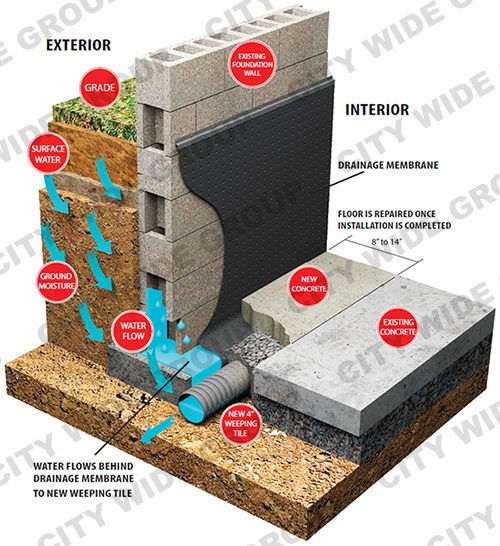So, you’ve found evidence of water damage in your basement. Now what? You need to protect your home’s foundation which is the basis for comfortable living. Whether a little water or a lot, you need to take steps to stop it from creating havoc. You may hope it’s a one-off but once you have had water in your basement, you are likely to have it again.
Methods
There are a variety of ways to fix a wet basement including repairing the cracks by filling them with an expandable filler. This method is certainly the least expensive in the short term but can be seen as using the proverbial finger in the dyke to solve a bigger problem. Unless this is just a short-term repair while you wait for a thorough waterproofing project, the water is likely to find another route inside. Water always finds the easiest path to follow.
Having your basement professionally waterproofed is the way to keep water out of the basement. The two common methods used are interior or exterior. While the interior method can be less expensive, it is also a different solution to the water problem — it channels any water that seeps into the base of your foundation to a drainage system or the sump pump. The exterior method stops the water from entering altogether.
Interior Waterproofing
The Interior method of waterproofing your basement will include repairs to any cracks and fissures, window wells, doorways, and a trench being dug around the inside perimeter of your foundation. Once the trench is dug, a weeping tile drainage system is installed either leading to a sewer drain or a sump pump. The trench is re-filled with gravel to encourage drainage, a net to stop debris from plugging the drainage, and then cement to return your basement floor to being level. This is an effective way to deal with water problems in your basement. It is less expensive than the exterior method of waterproofing.

Exterior Waterproofing
The Exterior method of waterproofing involves repairs to any problem areas in the basement and then a large ditch is excavated around the outside perimeter of your home down to the footings. The exterior walls are cleaned, repaired and then covered with a rubber membrane to stop water from entering the masonry. A weeping tile drainage system is installed and covered with a debris-resistant cover to draw water away, gravel is laid in and the soil around the walls returned and sloped to encourage water to seep away from the foundation. Your exterior is returned to how it looked before the work was done. A professional waterproofing company will re-install asphalt or interlock as it was before the work was done.

No matter which appropriate waterproofing method — interior or exterior — you choose, you will be taking on a project that involves some upheaval. You will have to remove furniture or things you have stored in the basement or you will have to accept that the outside of your home will be a construction zone for a while. However, the outcome will be the confidence that you have both protected the investment in your property and the health of your family. Having regular water problems in the basement can impact both the integrity of your home and your health — constant moisture issues can cause mould or other airborne bacteria to build up.
A company such as City Wide Group has years of experience and expertise to locate the source and recommend the right waterproofing project for you. The main considerations are budget and the obvious upheaval it will mean during the work. The investment is well worth the peace of mind to know your basement is going to be dry and that you will be able to rely on that for whatever uses you make of the space.










